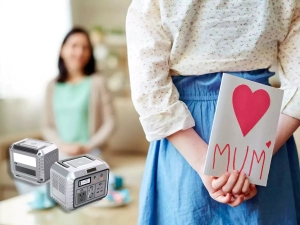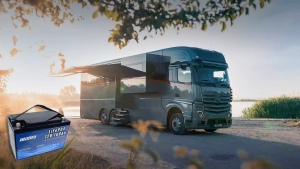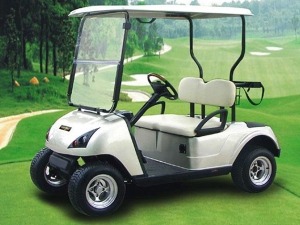Why 100Ah LiFePO4 Battery Is Best for Trolling Motor
Table of Contents
- Why 100Ah LiFePO4 Battery Is Best for Trolling Motor
- Why use a lithium battery for a trolling motor instead of a lead-acid battery?
- Are there any downsides or special considerations with lithium trolling motor batteries?
- What is the best battery to use for a trolling motor (and is a 12V 100Ah LiFePO4 a good choice)?
- How do I safely use and maintain a lithium trolling motor battery?
- What do real-world anglers say about switching to lithium batteries?
- Should you upgrade to a lithium battery for your trolling motor?
- Conclusion
- FAQ
- Learn More About Battery
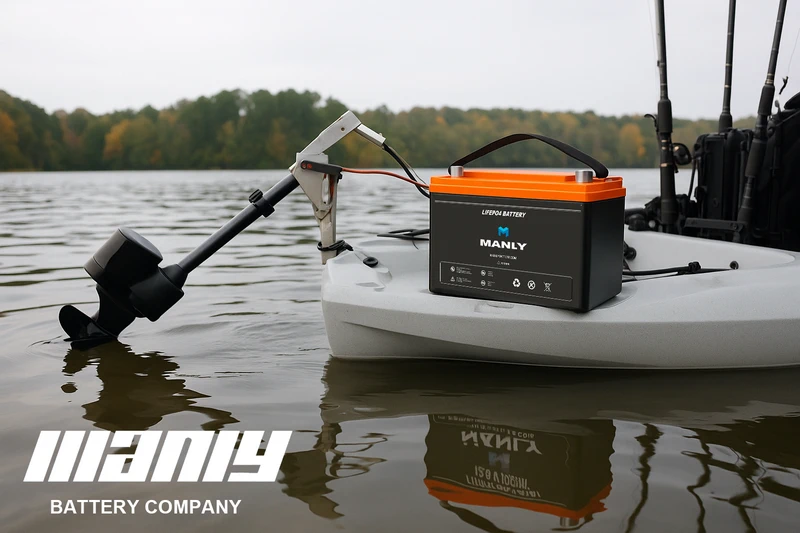
Why use a lithium battery for a trolling motor instead of a lead-acid battery?
Switching to lithium batteries for trolling motors offers major functional and operational benefits. Compared to lead-acid models, lithium options deliver better power stability, longer service life, and dramatically lower weight—all of which support higher efficiency and reduced lifecycle cost for commercial and recreational marine setups.1. Significantly Lighter Weight
LiFePO4 batteries typically weigh 50–70% less than equivalent lead-acid units. This reduction directly improves vessel performance, fuel efficiency, and ease of handling.- For example, the MANLY 12V 100Ah lithium battery weighs just ~28.5 lbs, compared to ~60 lbs for many sealed AGM models of the same voltage and capacity.
- One user replacing a three-battery lead setup with lithium reported over 100 lbs in total weight reduction—translating into better hole-shot acceleration and improved draft in shallow water.
2. Much Longer Lifespan and Cycle Life
100Ah LiFePO4 batteries can typically deliver 2,500–5,000+ full charge cycles before degrading to 80% capacity—equivalent to 8–10 years of regular marine use. In contrast, lead-acid deep-cycle batteries often require replacement within 2–3 years due to sulfation and voltage drop-off.- LiFePO4 systems support deeper discharges without damage, typically operating to 80–90% DOD (Depth of Discharge).
- Lead-acid batteries degrade rapidly below 50% DOD and are limited to <500 cycles in most real-world trolling motor setups.
3. Consistent Power and Longer Run-Time
Lithium systems deliver a steady voltage output until near full depletion, allowing your trolling motor to maintain consistent thrust and performance throughout the discharge cycle.- Lead-acid batteries often show voltage sag when their charge drops below 50%, causing loss of thrust and sluggish control.
- In contrast, a 12V 100Ah lithium battery can typically run a 55 lb thrust motor for 5–6 hours at cruising speed—up to 30% longer than equivalent AGM models.
4. Faster Charging and Higher Efficiency
Lithium batteries charge 2–3x faster than lead-acid counterparts, especially when paired with an optimized LiFePO4 charger. With charging efficiency near 95%, lithium systems return more stored energy per input watt.- In contrast, flooded or AGM lead batteries often max out at ~70–85% efficiency and require lengthy absorption phases that delay full recharge.
- Many users report recharging full 36V lithium bank setups in just 3–4 hours, compared to overnight charging for older setups.
5. Maintenance-Free and Reliable
Unlike flooded lead-acid batteries that require regular electrolyte checks and terminal cleaning, lithium systems are sealed, non-corrosive, and gas-free. With built-in Battery Management Systems (BMS), most modern units offer:- Automatic overcharge/discharge protection
- Bluetooth or LED status monitoring
- Storage readiness with <3% monthly self-discharge
6. Eco-Friendly and Safe
LiFePO4 chemistry eliminates toxic lead and corrosive acid from your battery system, reducing environmental risks and improving onboard safety.- Each lithium battery removes ~30–60 lbs of hazardous material compared to a typical sealed lead-acid unit.
- Batteries from reputable lithium battery manufacturers include BMS protections against short circuits, overtemperature, and electrical imbalance.
Are there any downsides or special considerations with lithium trolling motor batteries?
Lithium batteries provide outstanding runtime, weight savings, and long-term cost advantages—but transitioning from lead-acid involves key considerations. Below are the factors buyers should evaluate before integrating lithium batteries for trolling motors into their setup.1. Higher Purchase Cost
Lithium batteries carry a higher upfront price point—often 2 to 4 times that of lead-acid. For instance, a 50Ah lead-acid battery may cost around $150, while a comparable LiFePO4 option could exceed $800. This is due to the premium materials, internal Battery Management Systems (BMS), and higher energy density.- However, the total cost of ownership often tells a different story:
- Typical LiFePO4 lifespan: 3,000–6,000 cycles
- Lead-acid lifespan: 300–500 cycles
- Service life comparison: 8–10 years for lithium vs. 2–3 years for lead-acid
2. Charging Equipment Requirements
Lithium batteries require chargers with specific voltage and current profiles to operate safely and efficiently. Standard lead-acid chargers often lack the necessary charging algorithm for LiFePO4.- Required voltage for 12V LiFePO4: ~14.4V to 14.6V
- No need for float charging or equalization
3. Compatibility with Older Trolling Motor Systems
Lithium batteries maintain higher voltage under load, which may stress legacy trolling motor circuitry not designed for steady, high-voltage input.- Minn Kota guidance: Avoid continuous 100% throttle on brushed motors when powered by lithium
- Solution: Operate at ≤85% power for prolonged use on older models
- Alternative: Use lithium-optimized motors like the Minn Kota QUEST series
4. Cold Weather Charging Limitations
Lithium batteries discharge reliably in cold conditions but must not be charged below freezing (32°F or 0°C) unless they feature built-in thermal regulation.- Risk: Charging below freezing can cause lithium plating and permanent cell damage
- Solution: Store batteries indoors in winter or select models with integrated low-temp charging protection
5. Electrical System Integration
Lithium's flat voltage curve can confuse older analog gauges, which rely on voltage-based capacity readings.- LiFePO4 holds ~13.2–13.4V most of the cycle
- Voltage drops sharply near depletion, unlike lead-acid’s gradual slope
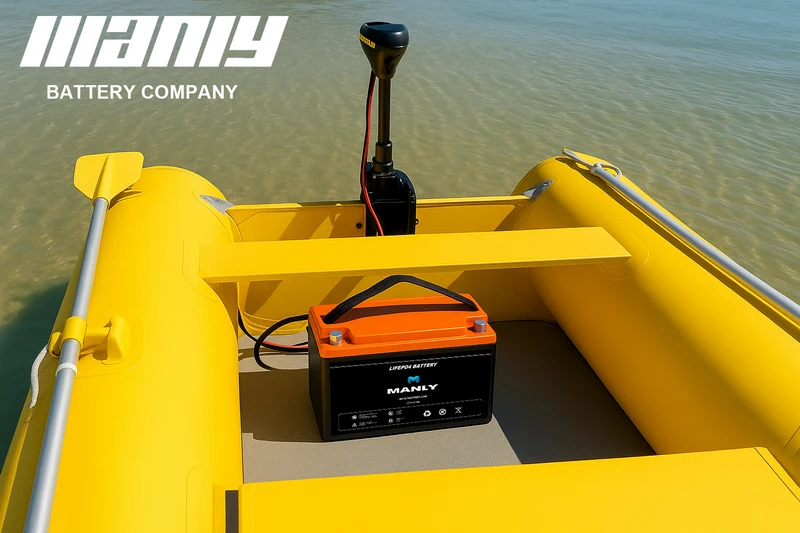
What is the best battery to use for a trolling motor (and is a 12V 100Ah LiFePO4 a good choice)?
A deep-cycle battery with sufficient capacity and stable voltage is critical for reliable trolling motor performance. Among the available options, a 12V 100Ah LiFePO4 battery is widely recognized as the optimal configuration for most 12V systems due to its balance of capacity, weight, and longevity.1. Voltage and Configuration
Most trolling motors used on kayaks, jon boats, and smaller vessels operate on 12V DC. Higher-thrust systems require 24V or 36V, typically achieved by wiring two or three 12V batteries in series.- 12V system → single 12V battery
- 24V system → two 12V batteries in series
- 36V system → three 12V batteries in series or one 36V battery
2. Capacity (Amp-Hours)
Trolling motors are high-demand loads, and adequate amp-hour capacity ensures runtime and preserves battery health. For most fishing scenarios, 100Ah is considered a practical benchmark.- 50Ah–60Ah: Sufficient for short outings or low-power motors
- 100Ah: Recommended for full-day use on 16–18 ft boats
- Group 27/31 compatibility: Most 100Ah LiFePO4 batteries match Group 31 footprints, simplifying replacement of lead-acid units
3. Lithium vs AGM vs Flooded Batteries
When comparing battery chemistries for trolling use, LiFePO4 consistently outperforms other options:| Type | Weight | Lifespan (Cycles) | Maintenance | Depth of Discharge |
| LiFePO4 | Very Low | 3,000–6,000 | None | 80–90% |
| AGM | High | 500–800 | None | 50–60% |
| Flooded Lead-Acid | Very High | 300–500 | Regular | 40–50% |
4. Recommended Example – MANLY 12V 100Ah Lithium Battery
The MANLY 12V 100Ah lithium battery exemplifies what a marine-grade deep-cycle unit should deliver:- Rated lifespan: 3,000–5,000 cycles (10–15 years under proper usage)
- Weight: ~33 lbs (vs. ~130 lbs for lead-acid equivalent)
- Form factor: Group 31 dimensions, IP67 waterproof casing available
- Features: Advanced BMS with protections for overcurrent, overtemperature, and cell balancing
- Customization: Options for terminal type, waterproofing, or industrial-grade enclosures
- Warranty: 10-year backed by a direct lithium battery manufacturer
5. Size and Mounting Considerations
Before installation, confirm the physical dimensions of the battery bay:- Most 12V 100Ah lithium batteries are slightly smaller than their lead-acid counterparts, allowing flexibility in tight compartments
- Batteries like MANLY’s can be mounted in various orientations (side or flat) due to their sealed design—but follow the manufacturer’s specs
- Secure batteries with appropriate brackets or marine-rated straps, as their light weight makes them more prone to shifting in rough water
How do I safely use and maintain a lithium trolling motor battery?
Maintaining a lithium battery for a trolling motor is simple but requires following key best practices. Unlike lead-acid systems, LiFePO4 units demand far less upkeep—yet their performance and longevity rely on temperature control, proper charging, and smart handling.1. Avoid Charging in Extreme Temperatures
Charging outside safe temperature limits shortens battery life and may trigger internal protection systems.- Safe charging range: 32°F–113°F (0°C–45°C)
- Safe operating range: –4°F to 140°F (–20°C to 60°C)
2. Charge After Each Use – Shallow Cycles Are Preferred
Lithium batteries for trolling motors don’t require deep discharge before recharge. In fact, partial cycling extends overall lifespan.- Charging after each trip reduces stress
- Shallow discharge (<60%) improves cycle count
- No float charging needed once full
3. Use the Right Charger – Avoid Lead-Acid Profiles
LiFePO4 batteries require chargers with a suitable voltage profile—typically 14.4–14.6V for 12V systems.- Use a LiFePO4-specific or multi-stage charger
- Avoid legacy lead-acid chargers with equalization phases
- Never use unregulated or trickle chargers
4. Secure and Protect the Battery During Use
While LiFePO4 batteries tolerate vibration better than flooded lead-acid types, physical damage from impact or loose mounting should still be avoided.- Mount in a dry compartment or IP-rated box
- Strap batteries securely to prevent bouncing
- Never place gear or weight directly on the battery
5. Monitor State of Charge (SOC)
Because lithium maintains a flat voltage curve, voltage alone isn’t an accurate way to gauge remaining capacity.- Use a Bluetooth monitor or integrated fuel gauge
- Avoid discharging below 10.5V (cutoff voltage for most 12V units)
- Try to recharge when SOC drops below 20–30%
6. Store at ~50% Charge During Off-Season
Long-term storage should keep the battery between 40%–60% SOC, especially in cold months or drydock periods.- Store in a cool, dry location above freezing
- Disconnect all loads and check SOC every 3–6 months
- Do not store at 0% or keep connected to a charger
7. Keep Terminals Clean and Secure
Even though lithium batteries don’t leak acid, marine exposure can corrode terminals or cause resistance if connections loosen.- Inspect terminals monthly
- Wipe off dust, salt, or oxidation
- Apply dielectric grease to prevent corrosion
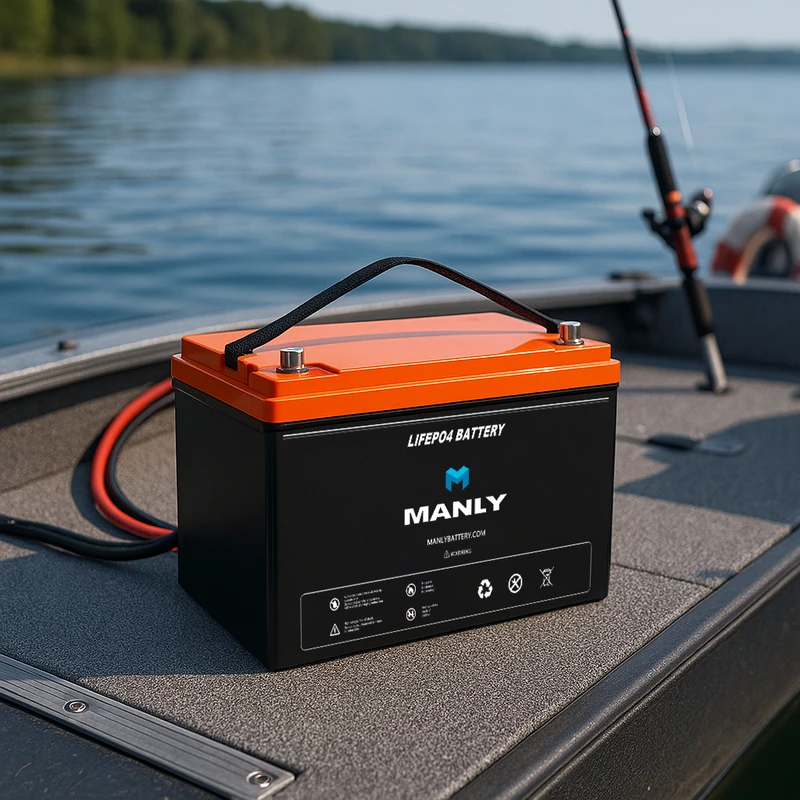
What do real-world anglers say about switching to lithium batteries?
Anglers who transition from lead-acid to lithium batteries for trolling motors consistently report major improvements in runtime, reliability, and overall vessel handling. Across bass boats, kayaks, and flats skiffs, the field data supports a clear pattern: lighter systems, longer sessions, and fewer battery-related issues.1. Tournament-Grade Reliability in Demanding Conditions
Competitive anglers often demand high-current endurance and uninterrupted power—criteria where LiFePO4 clearly outperforms.A professional bass tournament fisherman upgraded to a 36V lithium system using three 100Ah LiFePO4 batteries, replacing traditional deep-cycle lead-acid units. Prior to the switch, his batteries routinely failed by mid-afternoon, especially during windy tournaments with extended Spot-Lock use. After transitioning to lithium, he ran from launch to weigh-in with no power loss—even in strong current on the Mississippi River.Additionally, his starting and electronics batteries—two lithium units wired in parallel—kept his outboard engine and sonar displays powered reliably all day. No voltage drop, no startup failure. In his words, “I fish wherever I need to, and I know my system will last. That confidence changes everything.”2. Weight Reduction Improves Speed, Balance, and Fuel Efficiency
Switching from four lead-acid batteries to lithium removed approximately 300 lbs from the transom of the same angler’s bass boat. The result? Faster planing, better fuel economy, and improved hull balance—performance gains with direct operational benefits.On the small-vessel side, a kayak angler replaced a 50+ lb AGM battery with a 30 lb lithium battery. The weight savings not only improved paddling and top speed but also made setup and takedown less physically demanding. He noted, “What used to be a strain to lift—I now carry with one hand.”In commercial applications, this reduced weight translates into more payload capacity for gear, bait, or crew—especially valuable on flats boats, rental fleets, and multi-user charter vessels.3. Lower Long-Term Cost and Less Maintenance
While initial pricing remains higher, lithium’s extended lifecycle offsets replacement costs over time. With 3,000–5,000 cycles typical for 100Ah LiFePO4 batteries, many users calculate a lower cost per cycle compared to lead-acid systems that require replacement every 2–3 seasons.Users also report:- No more checking water levels or cleaning terminals
- No voltage sag under load
- Faster charging—saving hours between outings
4. Real-World Runtime and Performance Metrics
Saltwater anglers targeting redfish and snook on tidal flats often demand all-day runtime in wind and current. One inshore guide described running a 24V lithium system all day at variable speeds—with power left over at sunset.On a boating forum, a user detailed operating a 12V 100Ah LiFePO4 in Spot-Lock mode for over 6 hours continuously. The system still had ~20% state of charge at shutdown, while the previous dual-AGM setup would have required a recharge midway through the same session.These consistent voltage delivery profiles highlight one of lithium’s key advantages: unlike lead-acid systems, lithium batteries maintain full performance until nearly empty. This gives anglers predictable behavior throughout the entire day.5. Confidence, Control, and Consistency
From professional circuits to weekend tournaments, anglers value equipment that performs consistently under pressure. The MANLY 12V 100Ah lithium battery, for example, is engineered for marine use with a high-discharge BMS, Group 31 dimensions for compatibility, and waterproofing options for harsh conditions.- Users across platforms report:
- Zero runtime anxiety
- Stable voltage for sonar and GPS
- Faster recovery on chargers
- More time fishing, less time managing power
Should you upgrade to a lithium battery for your trolling motor?
For most boaters who rely on consistent trolling motor power, switching to lithium delivers measurable gains in performance, reliability, and lifecycle cost efficiency. The decision depends on your usage frequency, system demands, and long-term value expectations.1. For Frequent Users and Professional Applications
Anglers who fish multiple times a week or compete in tournaments experience the greatest return from upgrading. A 100Ah LiFePO4 battery offers:- Consistent power output throughout the entire discharge
- Longer runtime—ideal for all-day Spot-Lock or current fighting
- Cycle life exceeding 3,000–5,000 cycles, compared to 300–500 for AGM or flooded cells
2. For Occasional Users and Budget-Conscious Buyers
If you operate your trolling motor only a few times per season or for short durations, a traditional deep-cycle battery may suffice—especially when budget constraints are a priority.However, even light users can benefit from lithium’s:- Zero-maintenance operation (no water checks, no sulfation risk)
- Low self-discharge during storage (~2–3% per month)
- Lightweight design that reduces strain during handling or mounting
3. System Fit and Performance Priorities
Upgrading to lithium makes the most sense when system weight, runtime, or space is a limiting factor.Ask the following:- Do you fish from a kayak, jon boat, or other light hull?
- Is your current setup near its capacity limit?
- Do you value features like Bluetooth battery monitoring or rapid charging?

